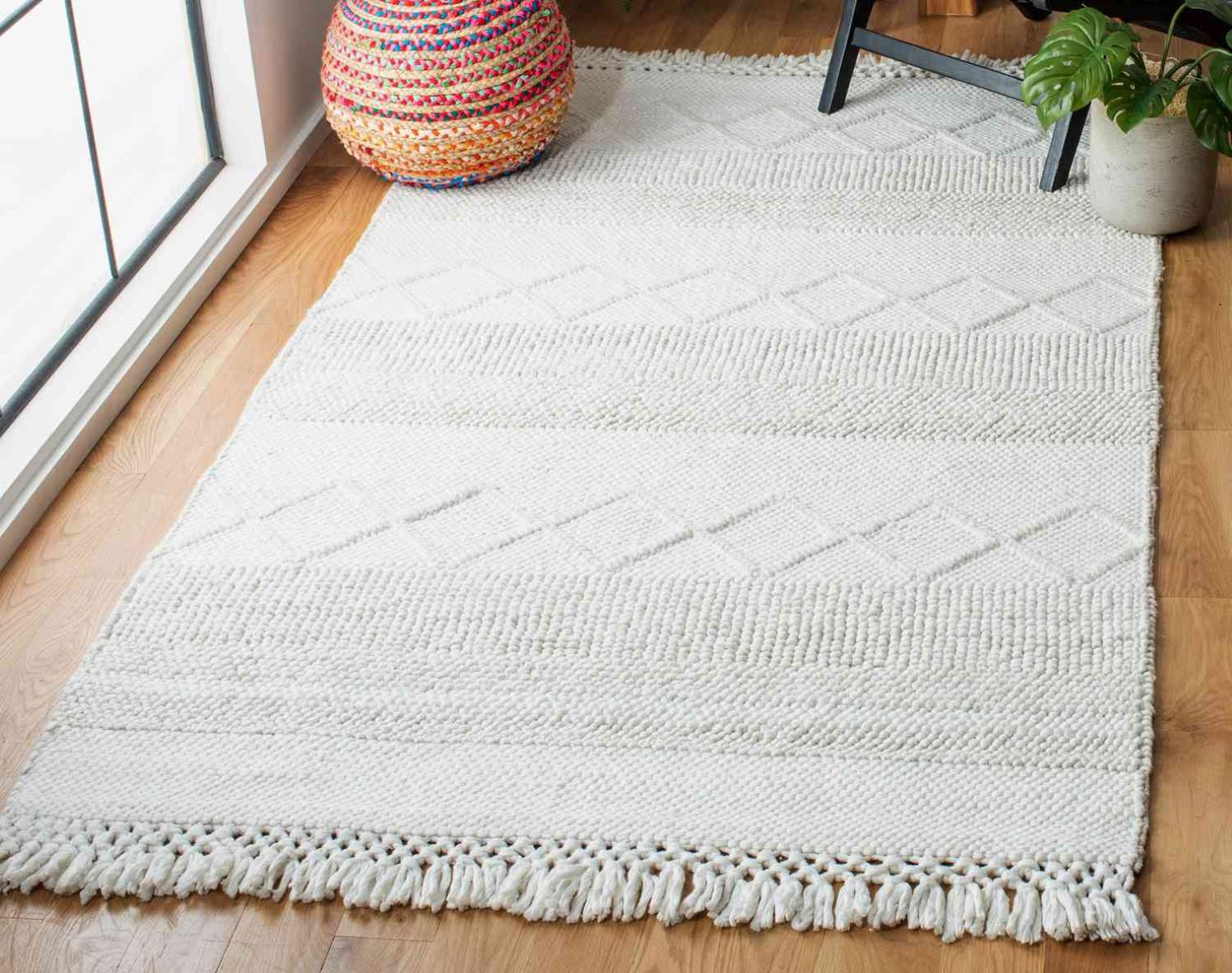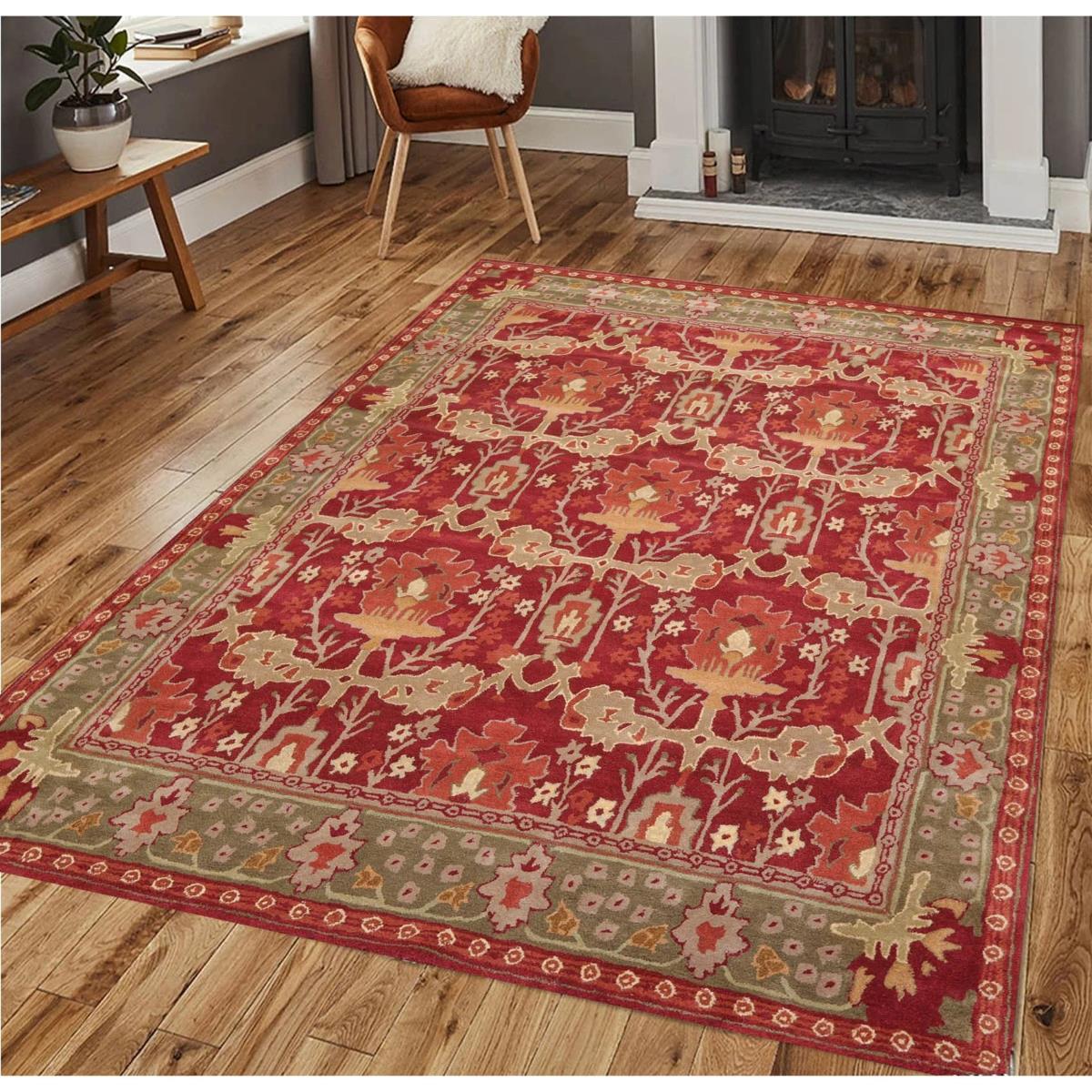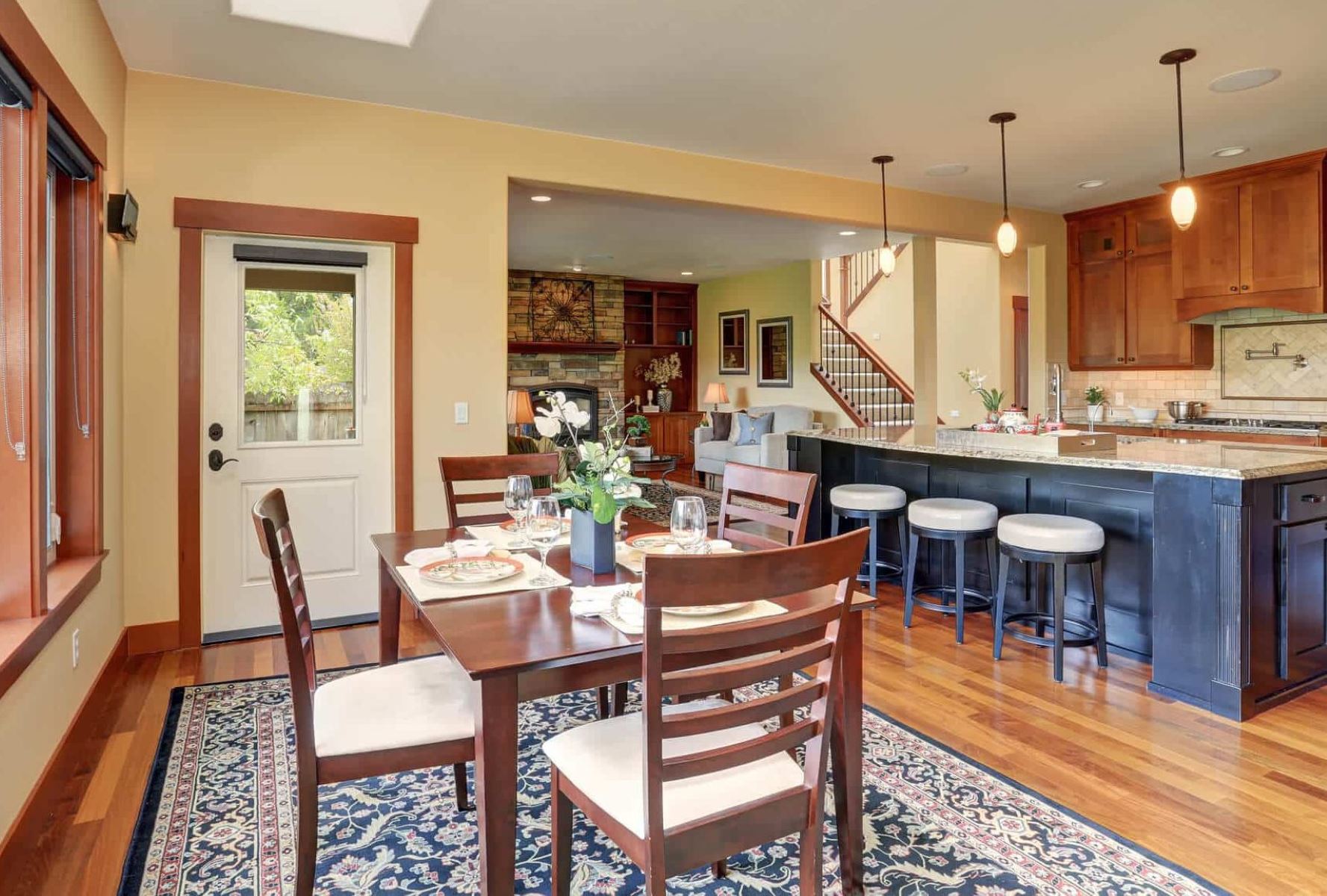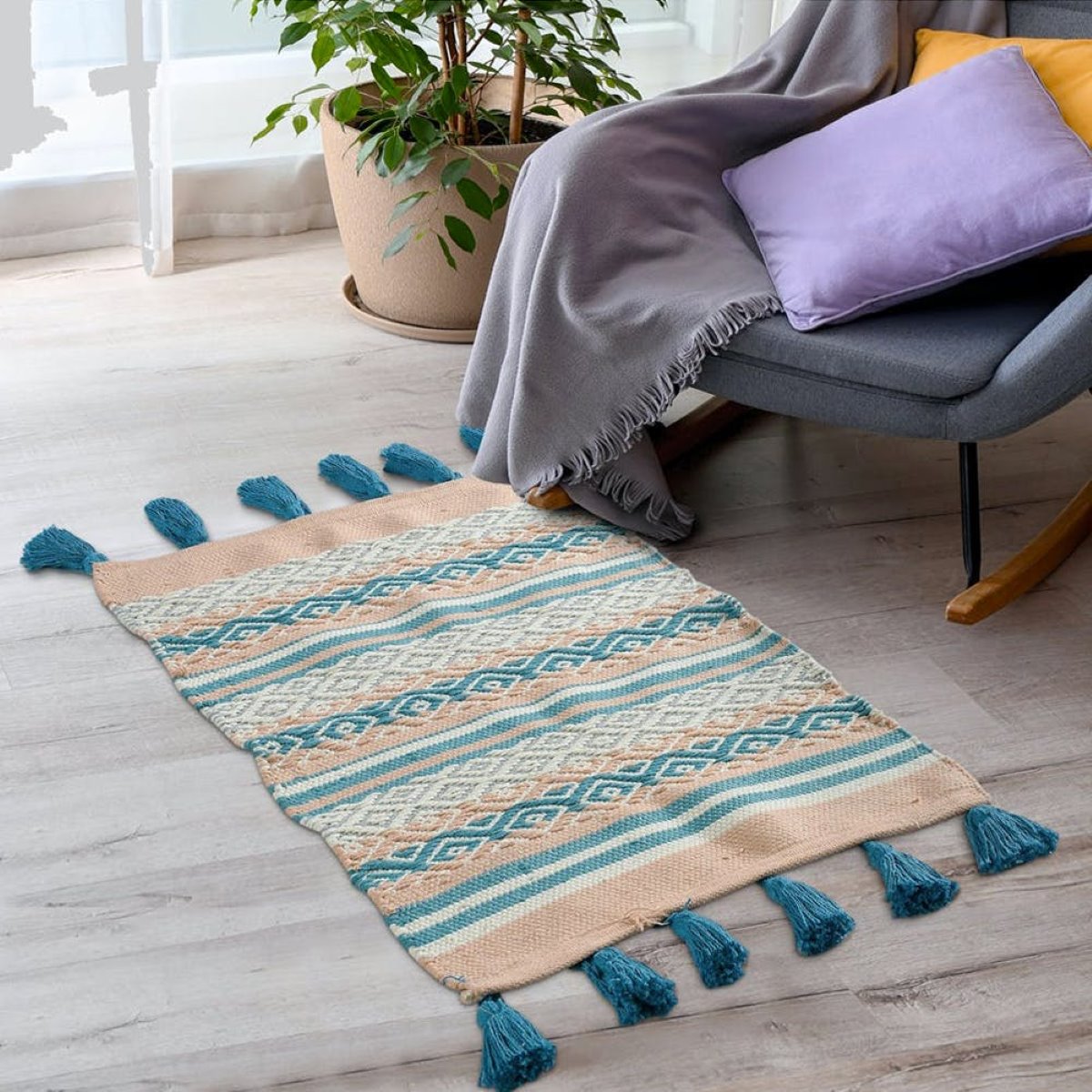

Articles
What Are Accent Rugs Used For
Modified: October 20, 2024
Discover the versatility and style of accent rugs in this informative articles. Learn about the various uses and benefits of accent rugs in your home.
(Many of the links in this article redirect to a specific reviewed product. Your purchase of these products through affiliate links helps to generate commission for Storables.com, at no extra cost. Learn more)
Introduction
An accent rug is a versatile and stylish addition to any home decor. Also known as area rugs or throw rugs, accent rugs are used to enhance the overall aesthetic appeal of a room while serving a variety of practical purposes. Whether you want to add a pop of color, define a specific area, or create a cozy atmosphere, accent rugs are an excellent choice.
In this article, we will explore the diverse uses and benefits of accent rugs, as well as provide guidance on how to select the perfect one for your space. Whether you are looking to revamp your living room, bedroom, or hallway, understanding the various types of accent rugs and their placement can help transform your space into a stylish and functional oasis.
From decorative purposes to functional uses, accent rugs offer numerous benefits. They not only enhance the visual appeal of a room but also provide insulation, comfort, and noise reduction. With so many styles, patterns, and sizes to choose from, you can easily find an accent rug that complements your existing decor or makes a statement on its own.
So let’s dive into the world of accent rugs and discover how they can elevate the style and functionality of your living space.
Key Takeaways:
- Accent rugs are not just decorative elements but also offer practical benefits such as insulation, noise reduction, and floor protection. They come in various styles, sizes, and materials to suit every design preference and functional need.
- When choosing an accent rug, consider factors like size, style, material, texture, and maintenance requirements. Proper placement and care can transform your space into a visually appealing and inviting oasis, enhancing both the style and functionality of your home.
Read more: What Is Home Decor Accents
Definition of Accent Rugs
Before we delve into the various uses and benefits of accent rugs, let’s first define what an accent rug is. An accent rug is a small to medium-sized rug that is used to add a decorative element to a room. Unlike larger area rugs that cover a significant portion of the floor, accent rugs are designed to enhance specific areas and create focal points within a space.
Accent rugs are typically made from a variety of materials, including wool, cotton, synthetic fibers, and natural materials like jute or sisal. They come in various shapes, such as rectangular, circular, or even irregular shapes, allowing them to fit into different areas of a room with ease.
What sets accent rugs apart from other types of rugs is their versatility. They can be used in virtually any room of the house, from the living room and bedroom to the kitchen and hallway. Whether you need to add warmth and texture to a hardwood floor or define a seating area in an open-concept space, accent rugs can fulfill a range of design and functional needs.
Accent rugs can feature a wide array of designs and patterns, from traditional Oriental motifs to modern geometric shapes. They come in various colors, allowing you to match them with your existing decor or use them to create a bold contrast in a neutral space. With their versatility in size, shape, material, and design, accent rugs can truly be customized to suit your personal style and preferences.
Now that we have a clear understanding of what accent rugs are, let’s explore the different purposes they serve in home decor.
Decorative Purposes
One of the primary purposes of accent rugs is to enhance the visual appeal of a room. They add a decorative element and serve as a focal point, drawing attention to specific areas within a space. Accent rugs can transform a plain and dull room into a vibrant and inviting space.
When it comes to decor, accent rugs offer endless possibilities. They can be used to introduce color into a neutral room or complement the existing color scheme. For example, a brightly colored accent rug can add a pop of vibrant energy to a minimalist living room, while a muted-toned rug can blend seamlessly into a bohemian-inspired space.
Another way accent rugs contribute to the overall aesthetics of a room is through their patterns and designs. From intricate floral patterns to bold geometric shapes, accent rugs can showcase a variety of artistic expressions. They can be used to create contrast or harmonize with the surrounding decor, adding visual interest and depth to a room.
Furthermore, accent rugs can be employed to define specific areas within a larger space. For instance, in an open-concept living and dining area, placing an accent rug under the dining table can visually separate the two areas and create distinct zones. This not only adds structure and organization to the space but also enhances the overall design cohesiveness.
Additionally, accent rugs can be used to soften hard surfaces like hardwood or tile floors. They add warmth, texture, and comfort underfoot, making the space more inviting and cozy. This is especially beneficial in areas where people frequently sit or walk, such as the living room or bedroom.
By using accent rugs strategically, you can create a cohesive and visually appealing space that reflects your personal style and elevates the overall ambiance of your home.
Functional Purposes
While accent rugs are primarily known for their decorative purposes, they also offer a range of functional benefits. They serve more than just a visual role and can enhance the practical aspects of a room.
One of the main functional purposes of accent rugs is providing insulation. They act as a barrier between your feet and the cold floor, especially in rooms with hardwood or tile flooring. With the added layer of an accent rug, you can walk barefoot comfortably, even during chilly weather.
In addition to insulation, accent rugs also offer sound absorption properties. They help reduce echo and minimize noise levels, making the room feel more serene and peaceful. This is particularly useful in high-traffic areas such as hallways or living rooms, where noise can be a concern.
Furthermore, accent rugs can be used to protect the underlying flooring from scratches, stains, and general wear and tear. Placing an accent rug in an area that receives heavy foot traffic, such as in front of a doorway or under a dining table, can prevent damage to the floor’s surface and prolong its lifespan.
Another functional aspect of accent rugs is their ability to provide a non-slip surface. This is particularly important in areas prone to moisture, such as bathrooms or kitchens. By choosing an accent rug with a non-slip backing or adding a rug pad underneath, you can create a safer environment and prevent accidents caused by slippery floors.
Additionally, accent rugs can help define pathways and guide traffic flow within a room. Placing a runner rug in a long hallway or along a staircase can effortlessly direct movement and create a sense of organization in the space. This not only adds functionality but also contributes to the overall design cohesion.
Overall, the functional purposes of accent rugs make them a practical addition to any room. From providing insulation and sound absorption to protecting the floor and creating safe pathways, accent rugs go beyond just decoration.
Types of Accent Rugs
When it comes to accent rugs, there is a wide range of types to choose from, each with its own unique characteristics and features. Understanding the different types can help you select the perfect rug that suits your style and meets your specific needs. Here are some popular types of accent rugs:
- Traditional Rugs: Traditional rugs feature classic designs and patterns, often inspired by Oriental or Persian motifs. These rugs typically have intricate details and a mix of rich colors, lending a timeless and elegant feel to any space.
- Modern Rugs: Modern rugs are known for their sleek and contemporary designs. They often feature abstract patterns, bold colors, and geometric shapes, adding a touch of modernity and sophistication to a room.
- Natural Fiber Rugs: Natural fiber rugs, such as jute, sisal, or seagrass, are made from eco-friendly materials. These rugs have a textured and organic look, bringing warmth and a rustic feel to a space. Natural fiber rugs are great for adding earthy and natural elements to your decor.
- Shag Rugs: Shag rugs are characterized by their plush and high-pile construction. These rugs are incredibly soft and luxurious underfoot, creating a cozy and inviting atmosphere. Shag rugs come in a variety of colors and textures, allowing you to add a touch of comfort and opulence to your space.
- Kilim Rugs: Kilim rugs are flat-woven rugs traditionally made by nomadic tribes. They feature vibrant colors and intricate geometric or tribal patterns. Kilim rugs are lightweight and versatile, making them a perfect choice for adding a bohemian or eclectic touch to your decor.
- Runner Rugs: Runner rugs are long and narrow rugs that are ideal for hallways, entryways, or staircases. They provide a decorative touch while also protecting high-traffic areas. Runner rugs come in various patterns and colors, allowing you to create a visually appealing pathway in your home.
These are just a few examples of the many types of accent rugs available. Whether you prefer a traditional, modern, or natural look, there is an accent rug out there to suit your taste and transform your space.
Accent rugs are used to add color, texture, and warmth to a room. They can also define a space within a larger room, protect flooring, and provide a comfortable surface to walk on. When choosing an accent rug, consider the size, shape, and material to best complement your space.
Read more: What Materials Are Used In Outdoor Rugs?
Choosing the Right Accent Rug
With the wide variety of accent rugs available in the market, finding the right one for your space can seem like a daunting task. However, by considering a few key factors, you can easily narrow down your options and find the perfect accent rug that complements your decor and meets your needs. Here are some tips to help you choose the right accent rug:
- Size: Consider the size of the area where you want to place the accent rug. Measure the space and choose a rug that fits proportionally. A rug that is too small may get lost in the room, while a rug that is too large may overwhelm the space.
- Style: Determine the style and theme of your room. Choose an accent rug with a design, pattern, and color that either matches or complements your existing decor. Consider the overall aesthetic you want to achieve, whether it’s traditional, modern, rustic, or eclectic.
- Material: Select a material that suits your lifestyle and the room’s function. For high-traffic areas, consider durable materials like wool or synthetic fibers that are easy to maintain and clean. For a natural and eco-friendly option, consider natural fiber rugs like jute or sisal.
- Texture: Think about the texture you desire for your space. Shag rugs offer a luxurious and plush feel, while flat-woven rugs provide a smooth and sleek texture. Consider how the texture of the rug will complement the other elements in the room.
- Color: Choose a color that enhances the overall mood and atmosphere of the room. Consider the existing color palette and decide whether you want the rug to blend in or make a statement. You can opt for a rug that matches the dominant colors or one that adds a pop of contrasting color.
- Maintenance: Consider the level of maintenance required for the rug. If you have pets or children, you may want to choose a rug that is stain-resistant and easy to clean. Additionally, check the care instructions to ensure that the rug’s maintenance aligns with your lifestyle.
Remember to take your personal preferences into account when selecting an accent rug. Trust your instincts and choose a rug that speaks to you and enhances your space. Don’t be afraid to mix and match patterns and textures to create a unique and personalized look.
By considering these factors and taking your time to explore different options, you can find the perfect accent rug that elevates the style and functionality of your room.
Placement of Accent Rugs
The placement of accent rugs plays a crucial role in not only enhancing the visual appeal of a room but also defining specific areas and creating a cohesive and well-designed space. Here are some tips on how to effectively place accent rugs:
- Living Room: In the living room, you can place an accent rug in the center of the seating area to anchor the furniture and create a cozy gathering space. Make sure the rug is large enough for all the furniture legs to be on it, or at least the front legs of the larger furniture pieces.
- Dining Room: In the dining room, place an accent rug underneath the dining table to define the eating area. Ideally, the rug should be large enough to accommodate all the chairs even when they are pulled out from the table. This ensures a comfortable dining experience.
- Bedroom: In the bedroom, you can place accent rugs on either side of the bed or at the foot of the bed to add warmth and texture. You can choose matching rugs or mix different shapes and sizes for added visual interest. Additionally, consider placing a larger rug under the bed, extending a few feet beyond the bed frame, to create a cozy feel when stepping out of bed.
- Hallway: In the hallway, consider using runner rugs to define the space and guide traffic flow. Place the runner rug along the length of the hallway, leaving a few inches of space on either side. This not only adds a decorative touch but also protects the flooring and creates a visual pathway.
- Entryway: In the entryway, a small accent rug can be placed near the front door to welcome guests and catch dirt and debris. Choose a durable and easy-to-clean rug that can withstand heavy foot traffic.
- Kitchen: In the kitchen, consider placing a small accent rug in front of the sink or stove to provide cushioning and comfort while standing. Look for a rug that is water-resistant and easy to clean to withstand potential spills and stains.
When placing accent rugs, ensure that they are properly positioned and not blocking any doorways or creating tripping hazards. It’s also important to consider the scale of the rug in relation to the size of the room and furniture.
Remember, the placement of accent rugs should not only enhance the functionality of the space but also contribute to the overall design and aesthetics of the room. Experiment with different placements to find the perfect balance that suits your style and meets your needs.
Maintenance and Care Tips
To keep your accent rugs looking their best and prolong their lifespan, proper maintenance and care are essential. Here are some maintenance and care tips to help you preserve the beauty and functionality of your accent rugs:
- Vacuum Regularly: Regular vacuuming is crucial to remove dirt, dust, and debris from the rug’s surface. Use a brush attachment or a vacuum specifically designed for rugs to prevent any damage.
- Rotate the Rug: To ensure even wear and tear, rotate your accent rug regularly. This helps prevent certain areas from becoming more worn than others, especially in high-traffic areas.
- Spot Clean Stains: Tackle spills and stains promptly by spot cleaning. Blot the stain gently with a clean cloth or paper towel, working from the outside of the stain towards the center to prevent spreading. Avoid rubbing the stain, as it can cause further damage to the fibers.
- Deep Clean as Needed: Depending on the rug’s material and level of use, deep cleaning may be required periodically. Follow the manufacturer’s instructions for deep cleaning or consider professional rug cleaning services for more delicate or intricate rugs.
- Avoid Direct Sunlight: Prolonged exposure to direct sunlight can cause fading and discoloration of the rug. Consider using window treatments to protect the rug from UV rays or rotate the rug periodically to minimize the impact of sunlight.
- Use Rug Pads: It’s recommended to use rug pads underneath accent rugs. Rug pads not only add an extra layer of cushioning but also provide stability and prevent the rug from slipping or sliding on the floor. They also help to protect the flooring underneath.
- Attend to Pet Hair: If you have pets, regularly remove pet hair from the rug’s surface using a pet brush or vacuum cleaner with a pet hair attachment. This helps to prevent the hair from embedding into the fibers and keeps the rug looking fresh.
- Avoid Using Harsh Chemicals: When cleaning your accent rug, avoid using harsh chemicals or cleaners that may damage the fibers or colors. Opt for mild, gentle cleaners specifically formulated for rugs or follow the manufacturer’s recommended cleaning instructions.
By following these maintenance and care tips, you can ensure that your accent rugs remain in top condition and continue to enhance the beauty and functionality of your space for years to come.
Conclusion
Accent rugs serve as versatile and stylish additions to any home decor. They not only enhance the visual appeal of a room but also offer practical benefits such as insulation, comfort, and noise reduction. With a wide range of styles, sizes, and materials to choose from, finding the perfect accent rug to complement your space is easier than ever.
Whether you are looking to add a pop of color, define specific areas, or create a cozy atmosphere, accent rugs can fulfill a variety of design and functional needs. From traditional oriental rugs to modern geometric designs, there is an accent rug suitable for every style and preference.
When choosing an accent rug, consider factors such as size, style, material, texture, and maintenance requirements. By selecting the right rug and placing it strategically in your living room, bedroom, hallway, or kitchen, you can transform your space into a visually appealing and inviting oasis.
Remember to properly care for your accent rugs by vacuuming regularly, rotating them to distribute wear, spot cleaning stains, and deep cleaning as needed. The use of rug pads can provide additional stability and protection for your rug and the underlying flooring.
Accent rugs are not just decorative accents; they play a functional role in creating a comfortable and stylish home. By understanding their purpose and making informed choices, you can enjoy the benefits of accent rugs for years to come.
So, go ahead and explore the world of accent rugs, unleash your creativity, and discover the perfect rug that will elevate the style and functionality of your living space.
Frequently Asked Questions about What Are Accent Rugs Used For
Was this page helpful?
At Storables.com, we guarantee accurate and reliable information. Our content, validated by Expert Board Contributors, is crafted following stringent Editorial Policies. We're committed to providing you with well-researched, expert-backed insights for all your informational needs.















0 thoughts on “What Are Accent Rugs Used For”